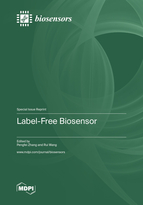Label-Free Biosensor
A special issue of Biosensors (ISSN 2079-6374). This special issue belongs to the section "Nano- and Micro-Technologies in Biosensors".
Deadline for manuscript submissions: closed (30 April 2023) | Viewed by 36650
Special Issue Editors
Interests: label-free biosensing and imaging; single-molecule imaging; cell analysis
Special Issues, Collections and Topics in MDPI journals
Interests: nanocrystal; biosensors; bio-imaging; SERS; TERS
Special Issues, Collections and Topics in MDPI journals
Special Issue Information
Dear Colleagues,
Label-free biosensors are an indispensable tool for analyzing intrinsic molecular properties, such as mass, and quantifying molecular interactions without interference from labels, which is critical for the screening of drugs, the detection of disease biomarkers and understanding biological processes at the molecular level. Recently developed approaches, including interferometric scattering microscopy, plasmonic scattering microscopy, and evanescent scattering microscopy, have pushed beyond ensemble averages and revealed the statistical distributions of molecular properties and binding processes by providing single-molecule imaging capabilities. These single-molecule imaging techniques pave the road towards understanding molecular interaction processes at a great level of detail. Nonetheless, the demand for developing novel single-molecule label-free sensing schemes that are cost-effective, easy to use, and especially applicable in commercial microscopy or other commercial label-free biosensors is ever increasing. Therefore, this Special Issue, " Label-free Biosensors", focuses on recent advances in the production of highly sensitive label-free biosensors, their applications in the detection and binding kinetics analysis of biological macromolecules such as proteins with a molecular weight larger than 100 kDa, and combination with other technologies for the efficient detection and screening of small molecules such as microRNA. We invite research submissions capable of helping advance the field of label-free biosensors and their applications for the efficient analysis of biomarkers.
With best regards,
Dr. Pengfei Zhang
Dr. Rui Wang
Guest Editors
Manuscript Submission Information
Manuscripts should be submitted online at www.mdpi.com by registering and logging in to this website. Once you are registered, click here to go to the submission form. Manuscripts can be submitted until the deadline. All submissions that pass pre-check are peer-reviewed. Accepted papers will be published continuously in the journal (as soon as accepted) and will be listed together on the special issue website. Research articles, review articles as well as short communications are invited. For planned papers, a title and short abstract (about 100 words) can be sent to the Editorial Office for announcement on this website.
Submitted manuscripts should not have been published previously, nor be under consideration for publication elsewhere (except conference proceedings papers). All manuscripts are thoroughly refereed through a single-blind peer-review process. A guide for authors and other relevant information for submission of manuscripts is available on the Instructions for Authors page. Biosensors is an international peer-reviewed open access monthly journal published by MDPI.
Please visit the Instructions for Authors page before submitting a manuscript. The Article Processing Charge (APC) for publication in this open access journal is 2700 CHF (Swiss Francs). Submitted papers should be well formatted and use good English. Authors may use MDPI's English editing service prior to publication or during author revisions.
Keywords
- label-free biosensing
- molecular interaction
- single-molecule detection
- imaging
- biological macromolecules
- proteins
- DNA
- RNA
- biomarkers








